Abstract
We studied the effect of transcranial electromagnetic stimulation on the acquisition of the active avoidance response with pain reinforcement in laboratory rats. We demonstrate that in male rats exposure of the brain to electromagnetic irradiation in the millimeter range with λ = 5.6 or 7.1 mm, modulated by a series of low-frequency pulses, prevented the acquisition of the conditioned avoidance response to a pain stimulus in 50% of the animals. The irradiation inhibited avoidance conditioning in an additional 25% of the animals. Similar treatment with transcranial electromagnetic stimulation after intraperitoneal injection of the antagonist of serotonergic receptors kytril did not influence avoidance conditioning. The electromagnetic brain stimulation did not affect the maintenance of the conditioned response in the animals that had developed it previously. Based on these data we hypothesize that the transcranial electromagnetic stimulation that was used in the present study promotes the synthesis of serotonin, which inhibits the formation of temporary connections during avoidance conditioning.
Similar content being viewed by others
Abbreviations
- TEMS:
-
transcranial magnetic stimulation
References
E. M. Wassermann, Ch. M. Epstein, U. Ziemann, et al., Oxford Handbook of Transcranial Stimulation (Oxford Univ. Press, 2008). ISBN-13: 978-0-19-856892-6.
J. Gever, Neurology 13 (2013).
K. R Cohen, S. Soskic, T. Iuculano, et al., Curr. Biol. 20 (22), 2006 (2010). doi 10.1016/j.cub.2010.10.007.
A. P. Parakhonskii and A. V. Rubtsovenko, Sovr. Naukoemkie Tekhnol. 2, 161 (2008).
I. G. Rodnova and M. S. Serdobintsev, Med. Farmatsevt. Nauki 6 (2013).
S. S. Nikitin and A. L. Kurenkov, Transcranial Magnetic Stimulation in Diagnosis and Treatment of Nervous System Diseases (Moscow, 2003) [in Russian].
T. Tsubokawa, J. Neurotrauma 12 (3), 345 (1995).
P. Deliac, E. Richer, J. Berthomieu, et al., Neurochirurgie 39 (5), 293 (1993).
V. M. Binghi, Magnetobiology (Milta, Moscow, 2002) [in Russian].
A. B. Gudkov, V. A. Karpin, N. K. Kostyukova, and E. S. Lovkina, Biophysical Aspects of the Ultraweak Magnetic Field (Ekologiya Cheloveka, Moascow, 2004) [in Russian].
V. E. Illarionov, Magnetotherapy (Librokom, Moscow, 2009) [in Russian].
E. A. Sheiko and A. I. Shikhlyarova, Int. J. Appl. A. Fund. Res. 9, 93 (2014).
S. N. Kartashov, E. V. Sharova, M. L. Kulikov, and A. M. Ermakov, http://www.kubanvet.ru/journ2-09-06.html.
K. Makowiecki, R. M. Harvey, and R. J. Sherrard, J. Neurosci. 34 (32), 10780 (2014).
A. L. Benabid, A. Koudsie, A. Benazzouz, et al., J. Neurology 248 (3), 11137 (2001).
P. Krack, V. Fraix, A. Mendes, et al., Mov. Disord. 17, SI88 (2002).
A. I. Toma, A. S. Inisimova, and V. A. Elkin, Zdorov’e i Obrazovanie v XXI Veke 13 (2), 126 (2011).
Z. A. Aleksanyan, E. B. Lyskov, G. V. Kataeva, et al., Ross. Fiziol. Zh. im. I.M. Sechenova 90 (8), 1 (2004).
V. P. Lapshin, Yu. S. Goldfarb, A.V. Zhao, et al., Fizioterap. Bal’neol. Reabilit. 1. 45 (2007).
M. V. Supova and S. N. Smirnova, Fizioterap. Bal’neol. Reabilit. 4, 38 (2007).
S. C. Cheetham, C. L. Katona, and R. W. Horton, in Biological Aspects of Affective Disorders, Ed. by R.W. Horton and C.L. Katona (Academic Press, London, 1991).
I. Anderson, S. Pilling, et al., The Treatment and Management of Depression in Adults (Br. Psychol. Soc. & Royal College of Psychiatrists, 2010).
M. Maes and H. Y. Meltzer, in Psychopharmacology: The Fourth Generation of Progress, Ed by M. Maes and H.Y. Meltzer (Raven Press, New York, 1994), pp. 933–944.
A. B. Kogan, Fundamentals of the Physiology of Higher Nervous Activity (Nauka, Moscow, 1972) [in Russian].
M. Yu. Stepanichev, Doctoral Dissertation in Biology (Moscow, 2010).
K. V. Sudakov, N. N. Karkishchenko, E. V. Koplok, et al., http://www.medjour.ru/issledovaniya/170-eksperimentalnoe-izuchenie-emotsij-i-pamyati.
A. V. Finkelstein and O. B. Ptitsyn, Protein Physics (KDU, Moscow, 2012) [in Russian].
T. Brinker, E. Stopa, J. Morrison, and P. Klinge, Fluids Barriers CNS 5, 8118 (2014).
L. D.Landau and E. M. Lifshitz, Quantum Mechanics, Vol. 3 of A Course of Theoretical Physics (Nauka, Moscow, 1963; Pergamon, New York, 1965).
L. A. Blumenfeld, Soros. Obraz. Zh. 4, 33 (1998).
H. M. Siegel, Metal Ions in Biological Systems (CRC Press, 1979; Moscow, Mir, 1982).
E. B. Shadrin, A. V. Il’inskii, V. M. Kapralova, and V. O. Samoilov, Nauch. Tekh. Vedomosti St.-Peterb. Gos. Univ. 77, 51 (2009).
N. D. Devyatkov, M. B. Golant, and O. V. Batskii, in Specific Features in Medical Biological Applications of Millimeter Waves (IRE RAN, Moscow, 1994), no. 4, pp. 33–38.
A. Yu. Grosberg and A. R. Khokhlov, Statistical Physics of Macromolecules (Nauka, Moscow, 1989) [in Russian].
L. Luo and J. Lu, arXiv:1102.3748v1 [q-bio.BM], 18 Feb 2011.
N. P. Didenko and O. V. Betskii, in Millimeter Waves in Medicine and Biology, Proc. X Ross. Symp. (Moscow, 1995), p. 135.
E. P. Khizhnyak and M. S. Ziskin, in Millimeter Waves in Medicine and Biology, Proc. XI Ross. Symp. (Moscow, 1997), p. 128.
V. I. Astafurov, A. A. Marennyi, and S. Yu. Semenov, in Proc. IV Russian Biophys. Congr. (Nizhni Novgorod, 2012), p. 16.
Author information
Authors and Affiliations
Corresponding author
Additional information
Original Russian Text © V.O. Samoilov, E.B. Shadrin, E.B. Filippova, Ya. Katsnelson, H. Backhoff, M. Eventov, 2015, published in Biofizika, 2015, Vol. 60, No. 2, pp. 377–384.
Rights and permissions
About this article
Cite this article
Samoilov, V.O., Shadrin, E.B., Filippova, E.B. et al. The effect of transcranial electromagnetic brain stimulation on the acquisition of the conditioned response in rats. BIOPHYSICS 60, 303–308 (2015). https://doi.org/10.1134/S0006350915020165
Received:
Published:
Issue Date:
DOI: https://doi.org/10.1134/S0006350915020165




